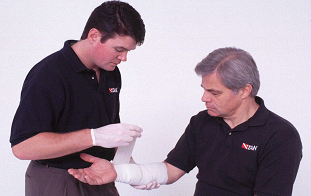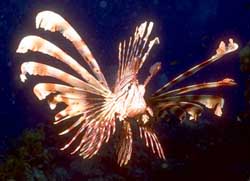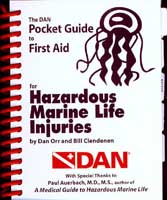|
CLICK HERE TO JOIN DAN: 
Intro | Overview | Find Instructor | Teach Course | Related Product
 A diver
surfaces from a dive in an area abundant with coral, removes
his fins and finds redness, swelling and blisters just beginning
to show on his left ankle. He also experiences a stinging
sensation on the same ankle. A diver
surfaces from a dive in an area abundant with coral, removes
his fins and finds redness, swelling and blisters just beginning
to show on his left ankle. He also experiences a stinging
sensation on the same ankle.
A diver, following a dive to an area filled with marine
life, notices a small bite pattern on his lower right leg
and some stiffness; he also experiences difficulty swallowing,
has a generalized weakness and a slight numbness in the
area of the bite.
A diver experiences pain, nausea and some swelling associated
with a purple-and-black puncture wound in his left knee.
The common thread from each of the three injuries is that
they likely came from contact with some form of hazardous
marine life. Given similar circumstances with you or a dive
buddy, would you be able to appropriately treat each injury?
Although serious hazardous marine life injuries are rare,
most divers experience minor discomfort from unintentional
encounters with fire coral, jellyfish and other marine creatures
at some point in their dive careers. Knowing how to minimize
these injuries helps you reduce diver discomfort and pain.
The First Aid for Hazardous Marine Life Injuries program
is designed to provide knowledge regarding specific types
of marine creature injuries and the general first aid treatment
for those injuries.
Intro | Overview | Find Instructor | Teach Course | Related Product
 Course Objective Course Objective
The objectives of this course are to train and educate the
general diving public and interested non-divers in the first
aid techniques for a suspected hazardous marine life injury.
In addition, this course will introduce divers to the identification
of potentially hazardous marine life and how to avoid hazardous
marine life injuries. This program also provides an excellent
opportunity for experienced divers and instructors to continue
their education.
Recommended Minimum Hours of Training
Knowledge Development (Lecture) = 1 Hour
Skills Development (Practice) = 3 Hours
This course should be taught as a four-hour module. The
time the course actually takes to teach varies depending
upon many factors including the number of students and their
ability to process the educational components of the program.
Instructors desiring to include subjects or training beyond
the course requirements may do so only before or following
the course. Any additional training must not be required
for completion of course requirements.
Learning Objectives
At the end of this program, First Aid for Hazardous Marine
Life Injuries course, participants will be able to:
- Identify the four types of hazardous marine life injuries.
- Name at least five venomous marine animals.
- List five common warning signs of an envenomation.
- Describe the appropriate first aid procedure for managing
a venomous marine animal injury.
- Name at least three aquatic animals that may bite a
diver.
- List two common warning signs of marine animal bite.
- Describe the appropriate first aid procedure for managing
a bite from a marine animal.
- Name at least three marine animals that may cause irritations
to the diver.
- List at least four common warning signs of irritations.
- Describe the appropriate first aid procedure for accidental
contact with aquatic life.
- Identify two common types of seafood poisonings.
- Name at least three types of fish that can cause seafood
poisoning.
- List three common warning signs of seafood poisoning.
- State the reason why evaluation by a medical professional
is necessary when seafood poisoning is suspected.
- Describe the appropriate first aid procedures for managing
suspected seafood poisoning.
- Perform a scene safety assessment.
- List the steps in performing a scene safety assessment.
- Assess the Airway, Breathing and Circulation (ABCs)
of an injured diver.
- Demonstrate a caring attitude towards a diver who becomes
ill or injured.
- Establish and maintain the Airway and Breathing (perform
Rescue Breathing) for an injured diver.
- Describe the importance of the use of supplemental oxygen
as a first aid measure for injured divers.
- Demonstrate the techniques for controlling bleeding
including direct pressure, elevation and the use of pressure
dressings and pressure points.
- Locate and demonstrate the use of pressure points to
control external bleeding.
- Apply dressings and bandages to manage wounds caused
by hazardous marine life.
- Demonstrate an ongoing assessment and manage shock.
- Demonstrate the pressure immobilization technique.
- List the components of an Emergency Assistance Plan.
- Describe at least five techniques or guidelines that
minimize the risk of injury from marine animals.
The nature and scope of this course is limited to training
divers and interested non-divers such as boat captains,
water enthusiasts and non-diving family members to identify
potential hazardous marine life; to provide first aid for
a hazardous marine animal injury; and to prevent injuries
caused by hazardous marine life. This course does not provide
training for cardiopulmonary resuscitation (CPR) or scuba
diving rescue. The training exercises of this course presuppose
that the ill or injured diver has already been brought to
shore or is aboard the boat.
Skill Performance Objectives
To successfully complete the DAN First Aid for Hazardous
Marine Life Injuries course, participants must demonstrate
skill and confidence providing first aid to injured divers
who have simulated hazardous marine life injuries.
Intro | Overview | Find Instructor | Teach Course | Related Product
 DAN's Pocket Guide
to First Aid for Hazardous Marine Life Injuries isn't a
definitive medical guide. But it is small and handy and
reminds divers of the necessary steps they'll need to take
to provide basic life support and first aid for injuries
caused by hazardous marine life. DAN's Pocket Guide
to First Aid for Hazardous Marine Life Injuries isn't a
definitive medical guide. But it is small and handy and
reminds divers of the necessary steps they'll need to take
to provide basic life support and first aid for injuries
caused by hazardous marine life.
This pocket-sized volume is divided into two easy-to-read
sections.
Section One reminds divers to use an emergency assistance
plan and summarizes basic life support measures, injury
assessment, rescue breathing and CPR, control of bleeding
and general physical assessment.
Section Two lists marine organisms, noting specific warning
signs, first aid procedures and treatments when divers,
swimmers and snorkelers are confronted with cuts, stings,
punctures or rashes associated with a particular creature.
Under the "Moray Eels" entry, for example, signs to note
include laceration and debris around the wound. First aid
entails controlling any bleeding and monitoring for infection.
As any good first aid manual, the guide lists the contents
of a fully appointed first aid kit. There is also a section
on the indicators and first aid for drowning, near-drowning
and injuries resulting from decompression illness, including
arterial gas embolism (AGE) and decompression sickness (DCS)
and lung overexpansion injuries.
Purchase this Product
|


 A diver
surfaces from a dive in an area abundant with coral, removes
his fins and finds redness, swelling and blisters just beginning
to show on his left ankle. He also experiences a stinging
sensation on the same ankle.
A diver
surfaces from a dive in an area abundant with coral, removes
his fins and finds redness, swelling and blisters just beginning
to show on his left ankle. He also experiences a stinging
sensation on the same ankle.
 Course Objective
Course Objective DAN's Pocket Guide
to First Aid for Hazardous Marine Life Injuries isn't a
definitive medical guide. But it is small and handy and
reminds divers of the necessary steps they'll need to take
to provide basic life support and first aid for injuries
caused by hazardous marine life.
DAN's Pocket Guide
to First Aid for Hazardous Marine Life Injuries isn't a
definitive medical guide. But it is small and handy and
reminds divers of the necessary steps they'll need to take
to provide basic life support and first aid for injuries
caused by hazardous marine life.